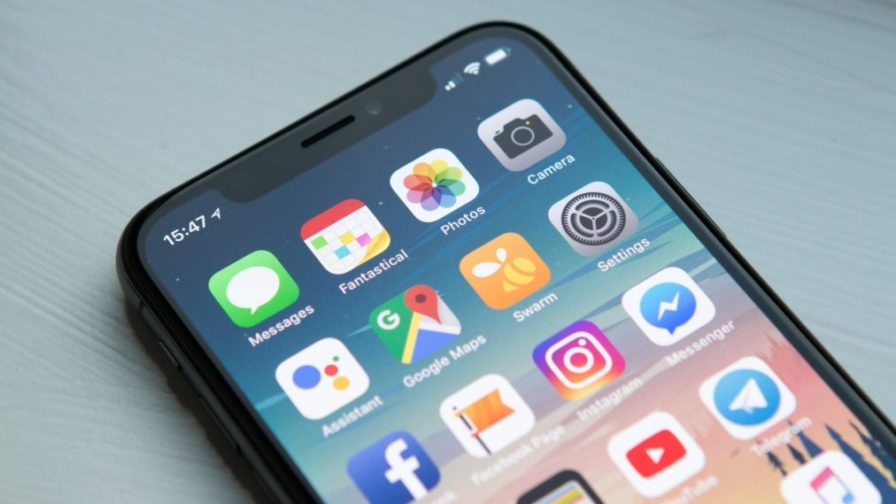
The mobile revolution
Before diving into native vs hybrid mobile app platforms, we need a little context. In the summer of 1983, at a conference in Aspen, a young Steve Jobs presented a vision of the future. This was many years before the advent of the iPhone. It was still six months before the launch of the first Macintosh computer. He was envisaging a new way to distribute software.
He imagined a store where people could download applications through phone lines. That predicted an app store. Twenty-four years later, the iPhone launched. In just over a year, the App Store emerged with 500 apps to choose from. Want to be able to create your own lightsaber? There’s an app for that.
The iPhone and its app store were a commercial, and critical success. It wasn’t long before other companies got in on the act. Google created the Android platform along with its Play Store. Amazon introduced the Amazon App Store, with the other big players following suit.
With the dawn of the smartphone came the emergence of the app developer. The possibilities provided by mobile technologies give developers the right skills, and opportunities to innovate. There are many things to consider when developing an app. An important choice is whether you should be developing a native app or a hybrid app.
Native vs Hybrid: 5 Key questions
Before deciding between native or hybrid, it’s a good idea to ask yourself some key questions.
- Are you developing the app on behalf of a client, yourself, or an employer?
- What is the development budget?
- How quickly does it need to be launched?
- Who is the target audience?
- What features need to be included?
The answers to these questions will guide your decision-making. If you’re struggling to answer any of them, then refer to your IT Infrastructure Library (ITIL) training for guidance.
It’s not a question of whether one is superior to the other; consider what app is best to achieve your aims.
What is a native app?
Native apps are designed to work on a specific platform or device. Usually, there are two major mobile platforms that you’re most likely to be developing for.
- iOS: This is Apple’s operating system. Apps are coded using Objective-C or Swift.
- Android: You’ll be using Java if you’re developing native apps for Google’s platform.
Apps designed for specific devices can take advantage of hardware to a greater degree. An example of this would be a sketch pad app that takes advantage of the larger canvas provided by a tablet screen.
An app developed for a specific platform will have access to that platform’s User Interface (UI). This means that the controls, and layouts that users will already be familiar with, can be integrated into the app.
Native apps provide improved reliability, and speed. This is thanks to their ability to take full advantage of the specific hardware or platform. As a developer, you will have a better idea of the tools available to you when designing a native app.
Examples of native apps
- WhatsApp – The communication app has a different version for iOS, and Android.
- Spotify – This music app can stream music over the internet. It can also download songs to the specific device being used.
- Pokemon Go – The popular game uses GPS, and camera features. A native app provides the best user experience in this case.
- Waze – By tapping into the device’s GPS, this native navigation app makes sure you don’t lose your way.
Some of the most recognizable brands in the world use native apps. For some of the examples above, it’s the functionality provided by this kind of app that’s key.
Native app benefits
As with any decision you make, a bit of cost-benefit analysis is in order. We’ve touched on some of the advantages of developing native apps. Let’s lay them out for the sake of clarity.
- Native apps are stable, and reliable.
- They can take advantage of the whole raft of platform-specific functionality.
- A native app will offer the best mobile app performance regarding speed, and responsiveness.
- The platform’s UI can be integrated into the app.
- Users are provided with a great experience.
- Native apps can function offline as well as online. This is dependent upon the specific utility of the app.
- Apps with graphics-heavy functionality work better natively. High definition games or complex animations can work through hybrid apps, but native apps have it easier.
- Native apps are less vulnerable to security risks.
- A quality experience should boost your digital customer engagement. This would be evident in the ratings your app receives.
- Native apps can use push notifications.
So native apps are the way to go, right? Not necessarily. Read on to see why native app development isn’t always the best route.
Native app drawbacks
In an ideal world, you would have unlimited time, and resources. We don’t live in a perfect world, however, so you should consider the disadvantages of native apps.
- To serve users across platforms, you need to code the app for iOS, and Android.
- Developing on multiple platforms means a longer development schedule.
- Teams would require a broader skills base, and would likely need to be larger.
- Longer schedules, and larger teams equate to higher development costs. Therefore, native app development quickly eats up resources.
What is a hybrid app?
A hybrid app is a cross between a native application, and a web application. Web apps are accessed through web browsers. A hybrid app is installed directly to a device, rather than running from a browser, but functions much like a web app.
An example could be a hybrid business communication app designed for multiple team members. They would likely be using a combination of platforms and devices, so a hybrid application suits their needs.
When developing a hybrid app, keep in mind that it will require internet access for full functionality. They can still operate offline but will not offer users the entire experience.
They’re developed using coding languages such as JavaScript, CSS, or HTML. Using application program interfaces (APIs) can access the mobile device’s features. By developing apps this way, developers can quickly get their apps onto both major platforms.
Examples of hybrid apps
- Evernote – the hybrid nature of this app allows users to sync their notes across devices.
- Amazon Shopping – you can keep your shopping cart across platforms.
- Instagram – HTML5 powers the social media app.
- Twitter – Another top social media brand using a hybrid app.
Hybrid apps have proved helpful to some other well-known brands. For these examples, the ease at which the app can function across platforms is key.
Hybrid app benefits
By the end of 2020, a whopping 74% of the top 50 retail apps on the US App Store were hybrid apps. Continuing our cost-benefit analysis, we should examine hybrid apps more closely. Let’s look at the advantages of hybrid apps, and see why they have proved popular.
- Using a single programming code language, hybrid apps can be used across platforms, and devices.
- Using a single codebase means easier updates, and maintenance.
- Development is made simpler by not having to build from the ground up for each platform.
- Apps can be deployed much more quickly than a native app.
- Reduced time frames equate to reduced resource drain.
- Hybrid apps can take advantage of dynamic web content. This provides opportunities for mobile affiliate marketing.
Hybrid app drawbacks
As you can see, hybrid apps offer unique solutions that native apps cannot. You should consider the disadvantages too.
- To operate correctly, hybrid apps require plugins, and APIs. These can present security risks.
- The user experience can suffer as hybrid apps cannot take advantage of the platform’s UI.
- A constant internet connection is required for full functionality. This is a result of hybrid applications’ commonalities with web apps.
- Being unable to take full advantage of the hardware, it is challenging to make inclusive design choices that take account of users’ differing levels of ability.
How to choose

Now you’re familiar with the options, it’s time to decide. How do you choose between hybrid, and native apps? You need to answer the five key questions we posed earlier.
- Are you developing the app on behalf of a client, yourself, or an employer? This will help you decide your priorities when developing an app. Are you looking to fulfill a brief as efficiently as possible? Or are you creating your masterpiece?
- What is the development budget? If you have a reasonable budget, you may have enough to develop native apps for both Android, and iOS. If your resource pool is shallow, you may be better off going the hybrid route.
- How quickly does it need to be launched? If speed is a priority, then you’ll likely consider a hybrid app. If you’ve got the time, and resources, a native app is worth considering.
- Who is the target audience? If your audience is quickly put off by the odd stability issue or glitch, they may not be able to contend with a hybrid app. The needs of a business manager who wants to monitor call center SaaS aren’t the same as the needs of someone shopping for the latest trends.
- What features need to be included? Consider how much the app needs to leverage the UI, and device features. Do you require the use of GPS? Will the camera be required?
Once you know what your app is trying to achieve while also considering budgetary parameters, you’ll be able to choose. Ensure that you keep the user experience in mind.
If the app must be able to access the camera, for example, quickly, then you’ll want to consider native apps. If, however, you’re developing an app for a retailer, then hybrid apps can easily integrate shopping cart software.
Budgets, and time pressures will often force our hands one way or another. Ensure that you keep the end-user experience in mind even when money, and schedule are to be considered.
Native apps: Key takeaways
Native apps provide the best stability, and security. They will tend to perform faster, and be able to handle the most demanding tasks. This kind of application is best placed to make use of the hardware functionality of specific devices. The user experience is smooth, and featureful.
When developing native apps, expect more extended time frames, and higher costs.
Hybrid apps: Key takeaways
Hybrid apps are easy to get onto iOS and Android. By utilizing a single codebase, you can reduce budget, and time costs. Hybrid apps can be the right choice for the proper purpose.
Users can experience hiccups more often than with native apps. Hybrid applications cannot take full advantage of available hardware, e.g., camera, GPS, etc. To reach their full potential, hybrid apps need a constant internet connection.
Summing up
One option is not better than the other option. Like tools in a hardware store, you want the right tool for the job.
App development is an exciting, and challenging pursuit. Deciding whether your app should be native or hybrid is one of those challenges. By considering everything discussed here, you should be better armed to make the right decision.




